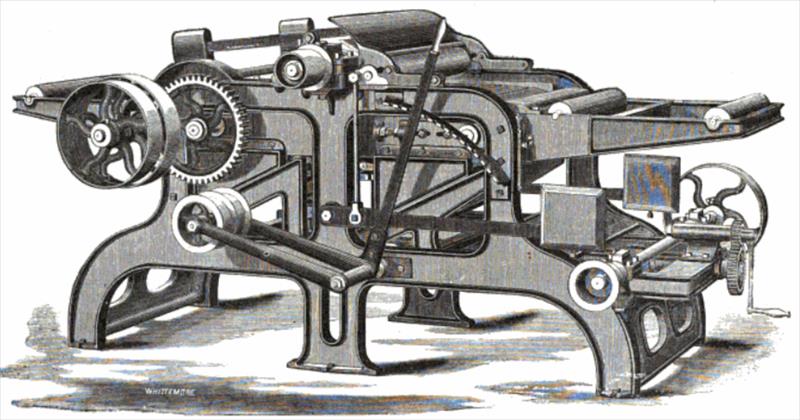John Farrar, under the business name of J. M. Farrar reportedly originated the traveling-bed planer as an attempt to avoid the Woodworth planer monopoly. The traveling-bed planer was patented by Joseph E. Andrews in 1845, and Farrar licensed this patent. Although this business seems to have been rather small and low-key, the Farrar name was synonymous with traveling-bed planers for a least a couple of decades after Farrar's business disappeared after about 1860. In that year it appears that Farrar opened a New York sales office, right on Broadway close to the World Trade Center location. Perhaps the financial strain of that move led to bankruptcy, but that is only a guess. Information on this maker is extremely scarce, and no machines made by Farrar are known to have survived.
 |
| Farrar planer made by Witherby, Rugg & Richardson, illustration from an 1872 article. |
Other manufacturers made "Farrar planers" under that name, notably J. A. Fay & Co., C. B. Rogers & Co., Witherby, Rugg & Richardson, and the Canadian firm of Cowan & Co., Ltd. Numerous other makers used the terms "endless-bed planer", "traveling-bed planer", or "lag-bed planer". Under any name this type of machine never found much success outside North America, and has since faded into obscurity even in the U.S., but they were once found very useful in mill shops. Compared to the Woodworth-style planers of the era, the traveling-bed planer was better able to handle frozen lumber, produced somewhat straighter and flatter output than a Woodworth-style planer, needed less adjustment and was less prone to jamming. On the downside, they were more expensive to purchase and when worn were expensive to rebuild. Woodworth-style planers continued to evolve; by the 1880s we see fewer traveling-bed planers in catalogs, and by the beginning of World War I they were large gone from the market.
Information Sources
- 1850 Catalog of the Sixth Exhibition of the Massachusetts Charitable Mechanic Association, page 16.
J. M. FARRAR, Manchester, N. H. Planing Machine. Is probably as good as any machine with a chain-bed plate.
- 1857 book, History of Prominent Mercantile and Manufacturing Firms in the United States, Volume VI, page 289, has a full-page ad from "Fay & Co's Machinery Depot", featuring Farrar's Patent Planing and Matching Machines.
- 1858 Historical and Genealogical Researches and Recorder of Merrimack Valley, page 211.
J. M. Farrar & Co., Elliott's Block, above Merchant's Exchange, on Manchester Street, who occupy two rooms, one 50 by 25 and the other 25 feet square, in manufacturing their Planing and Matching Machines, which they sell all through N. E. and Canada, and disposed of 115 of them last year, sold this spring over $4000 worth to Chicago, and $2500 to St. Louis. This machine is capable of planing 48 feet, running measure, of boards per minute, and is of convenient size to be portable.
- 1860 Trow's New York City Directory, page 48 in the back matter, text ad under the category of "Planing Machines".
John M. Farrar
Manufacturer of planing and matching machines, under Andres' Patent extended, with Single or Double Cylinder.
Five sizes, prices from $200 to $750; weight, from 1,200 to 4,700 lbs. This machine received a Diploma at the U. S. Fair at Chicago, October, 1859.
Office, 168 Broadway.
The 1859, 1862, 1865 Trow's Directory do not list J. M. Farrar.
- 1865 Transactions of the Department of Agriculture of the State of Illinois reports on that year's State Fair, including "Plowing Machine: J. M. Farrar, Manchester, New Hampshire. Very highly commended."
- 1875 patent 163,907 (for a combined carpet-stretcher and tack-driver) was granted to one George A. Alger of Manchester and assigned to Samuel G. Parker and John M. Farrrar of Nashua, NH.